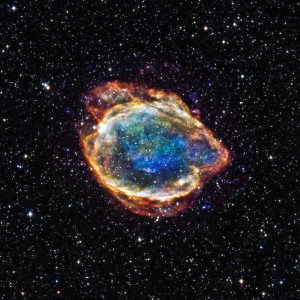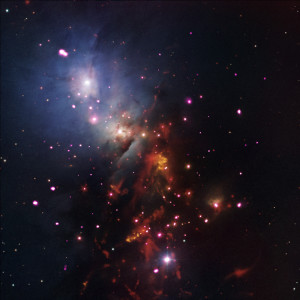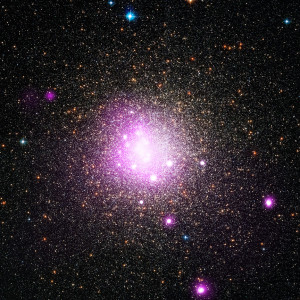NASA’s Chandra X-Ray Observatory, designed to detect X-ray emission from very hot regions of the Universe, has been revealing the msyteries of the universe for 16 years now. One of the Great Observatories, Chandra was carried to space in the payload bay of STS-93 and is still providing extremely useful scientific data to researchers today.
Click here for a gallery of Chandra images!

This debris field, which glows brightly in X-rays, was left over when a star exploded about 4,500 years ago. This object, known as G299.2-2.9, belongs to a particular class of supernovas called Type Ia. Astronomers think that a Type Ia supernova involves a thermonuclear explosion – involving the fusion of elements and release of vast amounts of energy – of a white dwarf star in a tight orbit with a companion star. In the Chandra image, red, green, and blue represent low, medium, and high-energy X-rays, respectively, detected by the telescope. The X-rays have been combined with optical and infrared data, which show the stars in the Chandra field of view.

NGC 1333 is a cluster that contains many stars that are less than two million years old, which is very young in astronomical terms. This new composite image combines Chandra’s X-rays (pink) of NGC 1333 with infrared data from Spitzer (red) and visible light data from ground-based telescopes (red, green, and blue). The Chandra data reveal 95 young stars glowing in X-ray light, 41 of which had not been identified previously. In addition, X-ray observations can reveal information about the physical properties and behaviors of these very young stars.

Using Chandra and several other telescopes, researchers have found evidence that a white dwarf star – the dense core of a star like the Sun that has run out of nuclear fuel – may have ripped apart a planet as it came too close. This composite image provides one of the clues: Chandra shows that the X-rays (pink) are not coming from the cluster’s center, as is evident when combined with visible light data from the Hubble Space Telescope (red, green, and blue). Instead, the details of the combined datasets point to a possible tidal disruption where one astronomical object destroys another through powerful gravitational forces.

